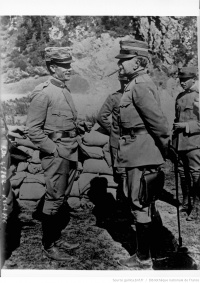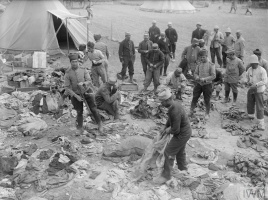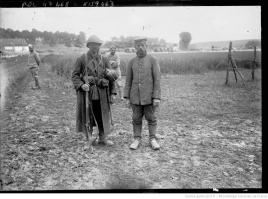The French Foreign Legion before World War I↑
After its foundation in 1831, the Foreign Legion fought in both European and colonial wars. The Legion’s main task was to serve French imperialism with deployment in colonial conquests and counter-insurgency in Africa, Mexico, Indochina, and the Middle East. In the late 19th century, the Legion became part of France’s North African “Armée d’Afrique”. It included men from all over Europe who had signed renewable five-year contracts. The overwhelming majority of applicants were motivated by poverty and unemployment. Douglas Porch has correctly argued that the history of the Legion is “also a history of a portion of the European working class in the nineteenth and twentieth centuries, one which a Marxist historian might claim had slipped through the fingers of the ‘capitalist revolution’.” The second largest group of Legionnaires were political refugees. Perceptions of the Legion have always been ambivalent. Its image as an alleged reservoir of criminals and runaways has been countered by notions of the romantic legionnaire.
Recruitment Patterns 1914–1918↑
At the beginning of World War I, the Foreign Legion deeply changed its character. This was mainly due to a decree from 3 August 1914, which allowed foreign volunteers to enlist “for the duration of the war”. As French law forbade foreigners from joining the regular army, these enlistments had to be in the Foreign Legion. In the days before the enlistment decree there had been several calls to serve for France, including one by a group of intellectuals living in France led by the Swiss novelist and poet Blaise Cendrars (1887–1961). Cendrars himself immediately joined the Legion and lost his right arm in September 1915, an experience he would describe in his autobiographical book La Main coupée (1946). Those willing to serve for France included, amongst others, Italians, Russian expatriates, East European Jews who had fled to France in the 1890s, nationals of neutral countries (including the American poet Alan Seeger (1888–1916)), members of minorities of the Habsburg Empire, and allegedly even 800 Germans and Austrians. Their motives included a love for France and its political system and the wish to participate in a war that was anticipated to be short, but in some cases also the need to avoid unemployment after the closing of factories upon mobilization. Altogether nearly 43,000 foreigners enlisted in the French army during World War I, although not all of these served in Foreign Legion units. It is, however, nearly impossible to get a concrete picture as to the national composition of these volunteers. Different authors mention different figures, usually without disclosing their sources. It is also often unclear whether these figures are meant to represent the overall number of volunteers from a specific country or just the ones who joined the French army in 1914.
Deployment and Perceptions↑
In the summer of 1914 the Foreign Legion, as usual, was dispersed to colonial locations in Morocco, Algeria, and Indochina. When the war broke out the Algerian battalions were ordered to send half of their manpower to France to incorporate the new recruits and form four new Legion regiments. Those staying in North Africa included a large proportion of Germans and Austrians, who in general displayed a remarkable loyalty to the French mercenary troop. Unlike the figures of the other units of the “Armée d’Afrique” fighting on European soil, the number of legionnaires did not increase, but displayed a sharp fall from 1914 to 1918. Whilst the overall number of legionnaires from 1913 to 1915 doubled to nearly 22,000, there was a drop to about 12,000 in the second half of the war.
The inclusion of allegedly idealistic wartime volunteers into the Legion would considerably, albeit only temporarily, change its image. The London Times during autumn 1916 characterised legionnaires as “fighters for an idea”, attributing to them “a deeply-rooted love of liberty and justice”: “The old idea that the Legion is a regiment of wrongdoers is exploded […].” However, the wartime Legion did not just consist of idealistic volunteers, and indeed, the amalgamation of “old” legionnaires arriving from the colonies and the wartime volunteers proved to be extremely difficult. The two groups’ mentality and outlook were radically different: Many of the new volunteers were patriotic, middle-class, politicized, and not at all happy to be incorporated into the infamous mercenary unit. “Old” Legionnaires, on the other hand, overwhelmingly stemmed from the lower classes, considered fighting a profession and hardly empathised with the idealistic volunteers.
A lack of experienced cadres added to these problems which, together with high casualty rates and widespread discontent, would soon result in a serious crisis that threatened the Legion’s fighting efficiency. In May and June 1915 there were several cases of mutiny. These problems forced the Legion to restructure and to restore much of its pre-war character. Many volunteers had left again after their own countries had entered the war. British and Belgian volunteers had very quickly been allowed to join their own national armies in 1914. The same applied to Italians in spring 1915. In mid-1915, wartime volunteers were also given the opportunity to fight in other French units, and many volunteers decided to do so. Those who remained in the Legion from now on were voluntarily there. New entrants only had to serve for a very short time in the Legion before being transferred to other units.
All these measures transformed the Legion on the Western Front from a gathering of reluctant foreigners to an elite regiment, considerably reduced in numbers, but strengthened in morale and fighting efficiency. It was not by chance, therefore, that the Legion would not be affected by the general morale crisis and mutinies of the French army in spring 1917. In November 1915 two Foreign Legion units had been merged into the “Régiment de marche de la Légion étrangère” which subsequently would fight at the Somme, at Verdun, in the second Marne battle and other theatres of war. Towards the end of the war, however, a serious dearth of recruits would jeopardize the Legion’s continued presence at the Western Front. Officially 4,116 members of the Foreign Legion were killed on the Western Front and another 1,200 in other theatres of war. Thus, roughly 10 percent of those serving in the Legion between 1914 and 1918 lost their lives.
Christian Koller, Schweizerisches Sozialarchiv
Section Editor: Emmanuelle Cronier
Selected Bibliography
- Comor, André-Paul (ed.): La Légion étrangère. Histoire et dictionnaire, Paris 2013: Robert Laffont.
- Dufour, Pierre: La légion en 14-18, Paris 2003: Pygmalion.
- Koller, Christian: Die Fremdenlegion. Kolonialismus, Söldnertum, Gewalt 1831-1962, Paderborn 2013: Ferdinand Schöningh.
- Porch, Douglas: The French Foreign Legion. A complete history, London 1991: MacMillan.
- Rockwell, Paul Ayres: American fighters in the foreign legion, 1914-1918, Boston; New York 1930: Houghton Mifflin.











